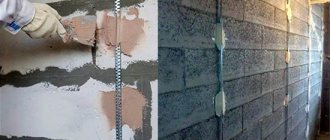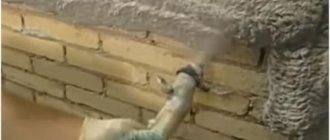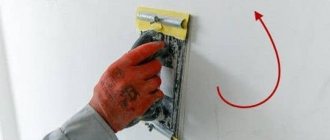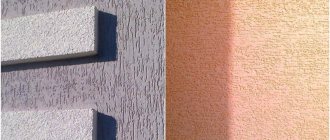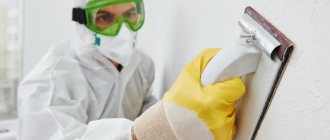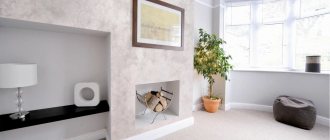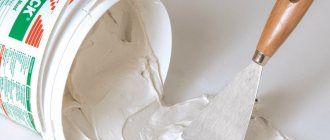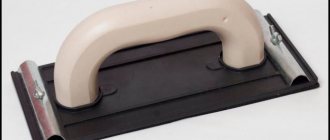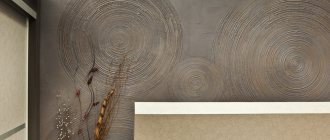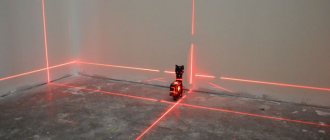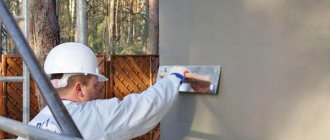Putty for wallpaper - how to check the quality?
Good afternoon
They putty on my walls under the wallpaper, I shined a flashlight and was horrified - sagging, traces of a spatula, etc. But at the same time, without a flashlight, it seems to be just fine. How to check the quality of putty specifically for wallpaper and argue with the master? Good afternoon, Pavel. If the putty is visually smooth, then this will be enough for the wallpaper, but running after the technician with a flashlight is stupid.
Those. Do you think that visual evenness is enough for puttying “under wallpaper”?
It’s smooth under thin delicate wallpaper, but under embossed wallpaper it’s not visible. They’ll do it just as they ordered. The end result will judge everyone. And I’m out of harm’s way, I always polish it under oblique light to avoid empty questions. I did it and forgot.
For painting, it is sanded to match the light bulb, and for wallpaper, usually without the light bulb. It is carefully sanded for thin wallpaper.
So that’s the question: what are the evaluation criteria? How can I see how thoroughly polished it is? Does your hand feel good? Is everything subjective?
A plastered and sanded wall should not have any differences or layers that may appear under the wallpaper. If the wallpaper is paper, then the slightest grain of sand will be visible. But if you don’t have experience, it’s difficult to check. You'll find out when you hang the wallpaper.
so that you sand it again on the vernik)))
Running with a flashlight? )))))))))))))))))))))))))))))))))))))))))))))))) )))))))))))) After puttying, no matter how ideal it is, there are almost always slivers left. Moreover, sagging is not always an unevenness, but a reflection of the structures of the layers.. You can check the quality of the evenness of the surface, but not with a flashlight. A rule or pattern. But I absolutely don’t understand why you need an ideal surface? Are you going to paint it? In 90% of cases, under wallpaper, simple puttying is enough. The most important thing here is that the overall surface is flat, so that there are no large bends, otherwise the wallpaper pattern may not match, but this is, excuse me, plastering work.
When accepting work from builders, it turns out that everyone around is an expert and knows everything about construction.
How can an amateur check the quality of plastered walls?
When undertaking renovations in a room, the owner must understand that gluing wallpaper on the wall, painting the wall covering or laying tiles on it is inappropriate until the putty has been completed. This is a necessary event to help level the wall to perfect condition. Naturally, carrying out such work on your own is difficult, sometimes impossible, so you have to involve specialized specialists, craftsmen who are not always conscientious and often do the work in haste.
Sometimes the work is simply done by amateurs who are not able to perform the putty efficiently. Naturally, after completing the wall finishing work, the owner must independently check the quality of the coating. Well, how can this be done if there are no special, professional skills in this area?
Construction level and paper bill
There is an elementary way for a person who understands little about construction activities to check the quality of putty without the participation of professionals. To do this, you need to take a building level in one hand and a 100 dollar bill in the other. The level is applied to the wall with a narrow end. No paper bill should fit between the wall and the level. If the bill slips through the gap formed (between the tool and the wall), it is 100% that the work was performed poorly. You can safely make claims to the builders, forcing them to redo the work at the proper, high level.
This method is very simple. It allows you to check the evenness of the wall. Ideally, there should be no differences, humps, or tubercles. High-quality putty walls:
- Smooth.
- Smooth to the touch.
- Fits tightly to the building level.
Using a flashlight
This is also a very simple method that allows you to instantly check the quality of the work performed. To do this, you need to take a light bulb and turn off the lights in the room. The lamp is brought to the wall so that the light is parallel to the wall surface. With such side lighting, almost all defects are visible. Ideally, there should be no shadows on the surface from tubercles or level differences.
What to look for?
A person who does not have experience in construction and accepts putty work from workers must clearly understand that they need to look at the places where the beacons were located. Usually there are bumps left there that shouldn't be there. You can also move both hands along the center of the wall, without lifting your palms from the surface, move them in one direction and the other, up and down. The wall should be smooth to the touch, without gaps, without bumps. Naturally, there should be no scratches, scuffs, or even cracks on the wall.
New publications are published daily on our Yandex.Zen channel
How to check the quality of plastering work in the kitchen and wet areas
Before starting work on plastering walls in the kitchen, you need to understand that in places where kitchen furniture is installed, it is necessary to achieve 90-degree angles whenever possible. Therefore, when ordering work, pay attention to this and learn how to check the evenness of the walls. To check the quality of plastering work in the kitchen and in wet areas, you will also need a 2.5 meter height rule and a new building level. Attention! For plastering wet areas, cement-sand plaster is used, and in no case gypsum. This must be checked before work begins. If this was not done, then you can check the plastered surface for strength and it will immediately become clear what type of plaster was used to perform the work. This can be done with any sharp object; the plaster wall will scratch very easily. And by the color of the dried wall you can determine the composition of the mixture. During further inspection, you can follow the same methods as when checking in residential premises listed above, namely.
1.Check deviations vertically and horizontally. 2. Check the evenness of the walls. 3. Check the strength of the plastered surface. 4. Check the corners 5. Check the parallelism of the walls. 6. Checking areas of special attention.
Attention! In wet areas, be sure to waterproof walls and floors.a
How to check the quality of wall putty before painting
The exact cost depends on the specific case. Puttying walls for painting in an unheated room? Leave a request or check by phone.
How independent experts can help you check the quality of putty.
In order to carry out such common repair and finishing work as plastering, including decorative plastering, wallpapering, painting, finishing and other works, you must first prepare the surfaces for their production. And such preparation always includes puttying as the main part. Creation of smooth surfaces, homogeneous in material and ready for continued repair, finishing, processing or installation on walls or other surfaces.
And for all those who are engaged in repairs, who order it from one or another contractor, in most cases, if they do not have their own professional experience, the question arises of how to check the quality of the putty.
Plastering walls for painting. High-quality repair
The video shows one of the options for high-quality and quick puttying of walls for painting, which we use in ours.
Putty is made by covering walls and other surfaces with special materials for leveling, and can be lighthouse, finishing, starting and other types, depending on what and how it is done. Repairs are now becoming more and more complex in terms of types and requirements that were not imposed on them before. Therefore, in many cases, with the question of how to check the quality of putty, customers are forced to turn to independent and fairly experienced professionals in order to receive advice and accurate assessments in unusual situations.
Checking flatness in a small area
After finishing the plastering work and preparing the wall surface for painting or wallpapering, as a rule, there are irregularities on the wall of 1-3 mm, which are inconvenient to find with a ruler. Defects are especially obvious on walls prepared for painting and painted in dark colors, on which direct sunlight falls at an angle. There is a simple technique that is used to determine the evenness of the wall after final finishing before wallpapering or painting.
How to check the verticality of a wall in a small area:
- At the beginning of the wall being measured, on the floor surface, we visually mark a square, which can be marked with some objects or drawn with chalk. This figure is needed in order to subsequently place the builder at the angle to the wall that you need.
- We make marks: point A corresponds to the laser plane perpendicular to the wall, point B defines the laser plane at an angle of 45° to the wall surface.
- Then we find points C, D, E, which are determined by dividing the corresponding segment between the wall and the previously selected mark. As a result, the angle values are obtained: 45/2 = 22.5, 22.5/2 = 11.25, 11.25/2 = 5.62.
- When the plane falls on the wall, it is level at any angle of inclination only if the wall is characterized by a perfectly flat surface. The presence of irregularities bends the beam, and the sharper the angle, the greater the curvature observed.
- In areas of unevenness, the beam will bend relative to the central point of the measured fragment:
- If the beam is bent away from the builder, that is, point A1, there is a hole in this place on the wall.
- If the beam is bent in the direction of the builder, which corresponds to point A2, then the wall is characterized by convexity.
- When the horizontal beam is tilted at an angle to the wall (in this case, the builder must be inclined relative to the horizontal plane), an unevenness will be detected on the wall from left to right, which corresponds to a horizontal curvature, and not from top to bottom, which is observed with vertical curvature.
Important! The dip or convexity can be calculated in millimeters. To do this, you will have to remember the trigonometric formula from the high school course. We will use the cotangent, which is defined as the ratio of the side adjacent to the corner (which corresponds to the distance A1) to the opposite side (which is the desired value, that is, the roughness X).
By changing the angle of incidence of the beam on the wall surface, the ratio of A1 to the desired value X changes. The smaller the angle of incidence, the greater will be the value of A1 or A2, which means the greater will be the coefficient: A1 / ctg “angle of incidence of the beam on the wall” = X.
How to check the quality of painting work
You don't need to be an expert to evaluate the results. It is enough to know where and how to look.
Repairs not only require a lot of money, but are also very exhausting. I don't want the next one to be needed soon. The fulfillment of this desire directly depends on the quality of work performed now.
The peculiarity of “painting” is that the final result depends entirely on the quality of work performed at each stage. Therefore, you have no choice but to control each stage. It will be a good help to be sure that correctly performed painting work gives a long-lasting result. Next time you won’t have to level the walls and putty again. Or you can simply re-glue the wallpaper or refresh the paint.
Of course, there are a lot of subtleties in this work. But it’s impossible to do without understanding the big picture. Let's see what result you need to get at each stage.
Preparatory work is required
It is important to carefully carry out preparatory work before painting internal surfaces: cracks must be repaired, walls and ceilings must be cleaned of dirt, dust and other types of contaminants. It is also necessary to tighten and level the surfaces; all unevenness must be smoothed out, puttyed and sanded with sandpaper or a polyurethane float until a flat and smooth surface is formed. If the wall or ceiling has already been painted, be sure to remove the old layer of paint using special means. For better adhesion (adhesion) of the coating to the base, it is recommended to prime the walls and ceilings. If the surface is made of plasterboard boards, the joints between the plasterboard sheets must be primed, glued with paint mesh, putty and then thoroughly sanded flush with the surface.
To ensure that there is enough paint, you can use a special tray, rolling it with a roller to remove excess paint from this hand-held painting tool. It is convenient to paint ceilings using a special roller extension. Yes, and remember about spotlights to check the painted layer.
Painting by yourself or hired specialist painters should be done efficiently, without unnecessary haste and very carefully. It’s better to spend more time and paint it well than to repaint everything again later. But still, when painting walls and ceilings on our own, we do not check so meticulously how the repair process was carried out, and even if there are small flaws, this is not really that important.
Stage 1. Removing old coatings
If you have started the initial finishing of a new building, this stage will be quick and easy. In older homes it can take several days or even weeks.
At this stage, all old and weak coatings that interfere with the new finish and/or threaten its durability should be removed.
Please note: we are talking not only about old finishing materials (wallpaper, whitewash and chalk putty, tiles, etc.), but also about plaster that has lost its strength. It definitely needs to be removed. You cannot build a house on a dilapidated foundation. New plaster applied over worn old plaster will simply fall off.
As a result of the work at this stage, only solid foundations should remain; they are primed and dried.
How to check
Feel the walls and ceilings in different places. The palm should remain clean and dry.
Assessing the curvature of a rough wall
Assessing the curvature of the rough wall helps determine the amount of work and draw up an approximate list of future material consumption.
The level works by constructing a virtual plane that is parallel to the wall surface and measuring the distance from the vertical plane to previously marked points. How to use a laser level to check the evenness of a wall:
- We select a mode on the laser level that helps to build a vertical plane, since the wall surface is located vertically. In the case of such work, a horizontal plane is displayed on the floor.
- We move the level as close to the wall as possible, while the plane should be parallel to the wall, the beam should not touch it anywhere.
- We prepare a ruler (a tape measure is not suitable), which we apply to the wall at different points. The resulting trace from the laser level determines the distance from the wall surface to the virtual plane.
- At different levels, every 40-50 cm we take measurements, which we enter into the table.
In this way, you can determine the point that corresponds to the most convex and most concave line, find the overall unevenness compared to the base vertical and determine the volume of plastering work.
Stage 2. Plastering the walls
Plastering is the most difficult and time-consuming stage of all. Its goal is to obtain smooth, flat surfaces. Ideally, the ceilings should be strictly horizontal, the walls should be vertical, and the angle between adjacent planes should be 90 degrees.
First, craftsmen install beacons - special metal guides. If we are talking about walls, the beacons must stand strictly vertically and be in the same plane. From the very beginning, you need to discuss what kind of accuracy you want to achieve. It is almost impossible to do all the work perfectly, so indicate which deviations are considered acceptable. For example, smooth unevenness of walls no more than two millimeters high is a very good quality.
The plaster should be thoroughly dried and then primed.
How to check
Using rules and levels. Apply the rule to the wall in several places, evaluate the unevenness. If the result is worse than you asked for, ask for improvements.
Dried plaster should be a uniform light gray color. Run your hand over it - it should remain dry and clean.
How to check the evenness of walls and the quality of plastering work in residential premises
Before starting work on plastering walls, you need to understand that there is simple plaster and high-quality plaster. To enable high-quality further finishing of the walls, high-quality wall plaster is used. Therefore, when ordering work, please pay attention to this. How to check the evenness of walls after plastering work. To do this, you will need a rule-level, preferably a new one 2.5 meters high, a new building level.
1.Check deviations vertically and horizontally. Differences in the plane of the walls from the vertical by 1 meter of their length by 1 millimeter are allowed. The entire height of the room is no more than 5 millimeters. The planes of the walls are 1 millimeter from the horizontal, per 1 meter of their length. Check this using a two-meter building level. Advice! Be sure to check every two meters of the wall surface.
2. Check the evenness of the walls. The surface can have no more than two irregularities of smooth outlines per 4 square meters with a depth or height of no more than 2 millimeters. The evenness of the walls is checked using the new rule - a level with a height of 2 or better 2.5 meters. It is applied to the plane first vertically, then horizontally, and the distance between it and the plastered surface is determined; it should not exceed 2 mm. Check the evenness of the surface under the radiators, on the walls where there are windows, in the area of sockets and switches, behind heating risers, in places where it is difficult to reach. Attention! Non-genuine builders believe that the ideal level should be at eye level, and will show you exactly these places, so be vigilant in this matter and check everywhere.
3. Check the strength of the plastered surface. Inspect the surface. There shouldn't be any cracks. Hit the surface with an open palm in several places at your discretion; if you hear a booming sound from the impact and feel peeling, then the work must be redone. Attention: Make sure that all metal beacons are removed from the walls.
4. Checking the corners If you have agreed with the performers to align the corners at 90 degrees, this is especially true in places where furniture and equipment are installed, then you can check the work as follows. The corners are checked not for evenness, since evenness will be ensured by the metal corners that are installed before the putty, but for deviations in degrees horizontally. For example, an angle of 89.9 degrees gives a wall 5 meters long, a deviation of about 1 cm. A 90 degree angle between the walls in a rectangular room is easier to check with a tape measure. You need to measure two diagonals of the room and compare them. If they are equal, then the walls form a rectangle, with right angles and parallel walls. You can also check the right angles of the walls using a long construction square at least 50 cm long; check the entire angle from floor to ceiling.
5. Check the parallelism of the walls. If you have agreed in advance on the walls, which should be strictly parallel to each other, then use a tape measure to measure the distance between them, at the beginning and at the end, it should be the same.
6. Checking areas of special attention. We do this in the same way using a building level rule. Important! Door trims, ceiling and floor plinths are smooth, so the junction areas of the plinths and platbands must be perfectly smooth so as not to get a gap in this place. Deviations of door and window slopes, arches, pillars, pilasters from the horizontal and vertical should not be more than 1 millimeter. The radii of curved elements, for example arches, should not deviate from the design value by more than 5 millimeters. This can be checked using the template pattern. The width of the slopes should not deviate by more than 2 millimeters from the design value. Check the entire perimeter of the slopes.
Stage 3. Putty
Plastering made the wall surfaces smooth, puttying should make them smooth. As a rule, putty is applied in at least two layers. Each layer is dried. Then the surface is sanded and primed again.
The thoroughness of this work depends on what finishing coating will be used for the final finish:
- Before painting you need to get a perfectly smooth surface.
- Thick vinyl wallpaper hides minor unevenness, so you don’t have to putty under it so carefully.
- Under ceramic tiles and similar finishing materials, as well as under some types of decorative plasters, there is no need to putty at all.
How to check
Take a good lamp and direct its light along the puttied surface. In oblique rays, all irregularities will be clearly visible. The surface should be clean and dry to the touch.
Stage 4. Finishing
If all previous work has been done efficiently, finishing will not take much time. If shortcomings of the previous stage appear, they will have to be eliminated, and this is a slow process.
It is stupid to examine the surface “under a microscope”: there will always be defects. It is quite enough that a person with normal visual acuity in good lighting does not see obvious deficiencies.
How to check the paint
Make sure that at least two layers of paint are applied. After complete drying (no earlier than the next day), check:
- Is the entire surface uniform in color and gloss (texture).
- Are there any paint drips or unpainted areas?
- Are there any noticeable marks from a brush or roller, fluff, grains of sand, etc.?
How to check wallpapering
Typically, wallpaper dries completely in no less than two to three days. Sometimes pasting defects may appear even later. Make sure there is good lighting and check if the result meets these criteria:
- The wallpaper should lie flat on the wall, without bubbles or unevenness.
- The joints of the panels should not diverge, and the edges should not peel off.
- Wrinkles in the corners of the room are not allowed.
- If the wallpaper has a pattern, it must be combined correctly.
